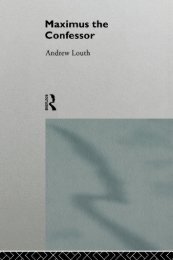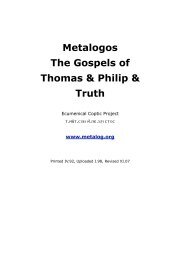Gospels of Thomas and Philip and Truth - Syriac Christian Church
Gospels of Thomas and Philip and Truth - Syriac Christian Church
Gospels of Thomas and Philip and Truth - Syriac Christian Church
Create successful ePaper yourself
Turn your PDF publications into a flip-book with our unique Google optimized e-Paper software.
www.metalog.org/files/supremacy.html.)<br />
In the early years following the discovery <strong>of</strong> these documents, <strong>and</strong><br />
before they could be given sufficiently careful scrutiny by scholars, it was<br />
commonplace for them collectively to be labeled ‘gnostic’ (see e.g. Grant &<br />
Freedman [1960], in Recent Scholarly Comments). This has always been a<br />
generic term for the Mediterranean mixture <strong>of</strong> essentially anti-sensory<br />
religious movements <strong>of</strong> the early centuries AD, <strong>and</strong> so was at first<br />
unfortunately considered a convenient category in which to place all <strong>of</strong><br />
the diverse Nag Hammadi writings. Subsequent investigation has shown,<br />
however, that neither <strong>Thomas</strong> nor <strong>Philip</strong> nor the Gospel <strong>of</strong> <strong>Truth</strong> can<br />
correctly be labeled gnostic, as they each explicitly affirm the reality <strong>of</strong><br />
our physical incarnations in their historic ambiance (including, most<br />
notably, the crucifixion): ‘Gnosticism’— whether Oriental, Platonic,<br />
Mystery-Religion or Theosophical— by definition considers the perceptible<br />
universe (including our own incarnate lives as well as all human history,<br />
Biblical or otherwise) to be inherently illusory <strong>and</strong> hence malignant. The<br />
unequivocal Old Testament view, on the other h<strong>and</strong>— which Christ in the<br />
canonical <strong>Gospels</strong> most certainly accepted— was that the entire realm <strong>of</strong><br />
the five senses is neither unreal nor evil, but rather divinely created <strong>and</strong><br />
good: so, among countless examples, Gen 1:31 (‘everything that He had<br />
made ... was very good’) <strong>and</strong> Lk 24:39 (‘flesh <strong>and</strong> bones as ... I have’). A<br />
careful reading <strong>of</strong> the three Coptic <strong>Gospels</strong> makes it abundantly clear that<br />
they are unequivocally within this quite un-gnostic Biblical tradition;<br />
see Comm.1, below.<br />
The New Testament canons <strong>of</strong> the Western (Catholic/Protestant), Eastern<br />
Orthodox, Coptic, Armenian, Ethiopian <strong>and</strong> Syrian/Nestorian <strong>Church</strong>es all<br />
differ significantly from one another— <strong>and</strong> even these were under dispute<br />
within the various branches <strong>of</strong> <strong>Christian</strong>ity until many centuries AD;<br />
previously there were only widely diverse opinions recorded by various<br />
individuals well after the Apostolic era, regarding not only today's<br />
commonly accepted works but also such writings as the Epistle <strong>of</strong><br />
5




